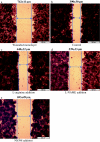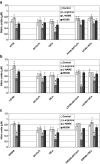Nitric Oxide (NO) and Cyclooxygenase-2 (COX-2) Cross-Talk in Co-Cultures of Tumor Spheroids with Normal Cells
- PMID: 21909878
- PMCID: PMC3170423
- DOI: 10.1007/s12307-011-0063-x
Nitric Oxide (NO) and Cyclooxygenase-2 (COX-2) Cross-Talk in Co-Cultures of Tumor Spheroids with Normal Cells
Abstract
Cyclooxygenases (COX), prostaglandin E(2) (PGE(2)) and nitric oxide (NO) are believed to be some of the most important factors related to colon cancer growth and metastasis. In this study, we aimed to investigate the associations between COX-2, PGE(2) and NO in co-cultures of human colon cancer spheroids obtained from different tumor grades with normal human colonic epithelium and myofibroblast monolayers. L-arginine (2 mM), a substrate for nitric oxide synthases (NOS), decreased COX-2 and PGE(2) levels, while N( G )-nitro-L-arginine methyl ester (L-NAME) (2 mM), a NOS inhibitor, had no influence on COX-2 and PGE(2) levels but limited tumor cell motility. NS398 (75 μM), a selective COX-2 inhibitor, had no significant influence on NO level but decreased motility of tumor cells. COX-2, PGE(2) and NO levels depended on the tumor grade of the cells, being the highest in Duke's stage III colon carcinoma. Summing up, we showed that addition of L-arginine at doses which did not stimulate NO level caused a significant decrease in COX-2 and PGE(2) amounts in co-cultures of colon tumor spheroids with normal epithelial cells and myofibroblasts. Any imbalances in NO level caused by exogenous factors influence COX-2 and PGE(2) amounts depending on the kind of cells, their reciprocal interactions and the local microenvironmental conditions. The knowledge of these effects may be useful in limiting colon carcinoma progression and invasion.
Conflict of interest statement
The authors declare that they have no conflict of interest.
Figures






Similar articles
-
Regulation of cyclooxygenase activity and progesterone production in the rat corpus luteum by inducible nitric oxide synthase.Reproduction. 2002 May;123(5):663-9. doi: 10.1530/rep.0.1230663. Reproduction. 2002. PMID: 12006094
-
The importance of release of proinflammatory cytokines, ROS, and NO in different stages of colon carcinoma growth and metastasis after treatment with cytotoxic drugs.Oncol Res. 2010;18(9):419-36. doi: 10.3727/096504010x12671222663593. Oncol Res. 2010. PMID: 20524400
-
Interaction between NO and COX pathways in retinal cells exposed to elevated glucose and retina of diabetic rats.Am J Physiol Regul Integr Comp Physiol. 2004 Oct;287(4):R735-41. doi: 10.1152/ajpregu.00080.2003. Am J Physiol Regul Integr Comp Physiol. 2004. PMID: 15371279
-
The cyclooxygenase 2-selective inhibitor NS398 inhibits proliferation of oral carcinoma cell lines by mechanisms dependent and independent of reduced prostaglandin E2 synthesis.Clin Cancer Res. 2003 May;9(5):1885-97. Clin Cancer Res. 2003. PMID: 12738747
-
Regulatory mechanism of duodenal bicarbonate secretion: Roles of endogenous prostaglandins and nitric oxide.Pharmacol Ther. 2011 Apr;130(1):59-70. doi: 10.1016/j.pharmthera.2010.12.006. Epub 2010 Dec 24. Pharmacol Ther. 2011. PMID: 21185865 Review.
Cited by
-
Silymarin and celecoxib ameliorate experimental varicocele-induced pathogenesis: evidences for oxidative stress and inflammation inhibition.Int Urol Nephrol. 2018 Jun;50(6):1039-1052. doi: 10.1007/s11255-018-1862-5. Epub 2018 Apr 5. Int Urol Nephrol. 2018. PMID: 29623501
-
Influence of nitric oxide signaling mechanisms in cancer.Int J Immunopathol Pharmacol. 2022 Jan-Dec;36:3946320221135454. doi: 10.1177/03946320221135454. Int J Immunopathol Pharmacol. 2022. PMID: 36260949 Free PMC article.
-
Post-translational modifications of prostaglandin-endoperoxide synthase 2 in colorectal cancer: An update.World J Gastroenterol. 2018 Dec 28;24(48):5454-5461. doi: 10.3748/wjg.v24.i48.5454. World J Gastroenterol. 2018. PMID: 30622375 Free PMC article. Review.
-
Mycotoxin Zearalenone Attenuates Innate Immune Responses and Suppresses NLRP3 Inflammasome Activation in LPS-Activated Macrophages.Toxins (Basel). 2021 Aug 25;13(9):593. doi: 10.3390/toxins13090593. Toxins (Basel). 2021. PMID: 34564598 Free PMC article.
-
Reciprocal regulation of the nitric oxide and cyclooxygenase pathway in pathophysiology: relevance and clinical implications.Am J Physiol Regul Integr Comp Physiol. 2013 Apr 1;304(7):R473-87. doi: 10.1152/ajpregu.00355.2012. Epub 2013 Feb 6. Am J Physiol Regul Integr Comp Physiol. 2013. PMID: 23389111 Free PMC article. Review.
References
-
- Rao ChV, Indranie C, Simi B, Manning PT, Connor JR, Reddy BS. Chemopreventive properties of a selective inducible nitric oxide synthase inhibitor in colon carcinogenesis, administered alone or in combination with celecoxib, a selective cyclooxygenase-2 inhibitor. Cancer Res. 2002;62:165–170. - PubMed
-
- Conners W, Whitebeck C, Chicester P, Legget R, Lin AD-Y, Johnson A, Kogan B, Levin R, Mannikarottu A. L-NAME, a nitric oxide inhibitor, diminishes oxidative damage in urinary bladder partial outlet obstruction. Am J Physiol—Renal Physiol. 2006;290:F357–F363. - PubMed
LinkOut - more resources
Full Text Sources
Research Materials

